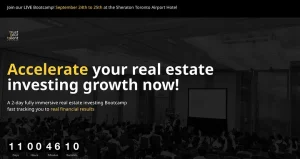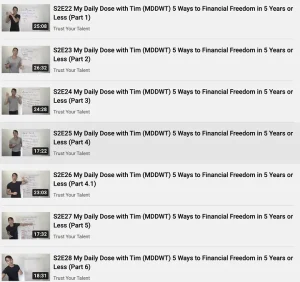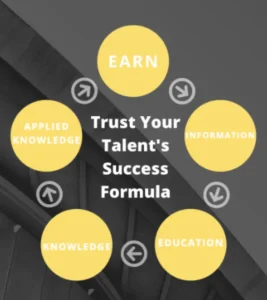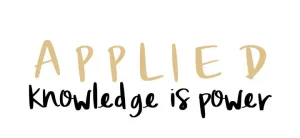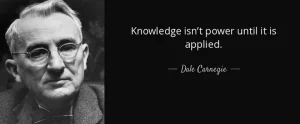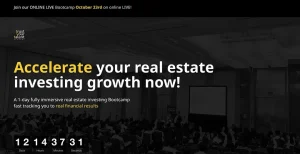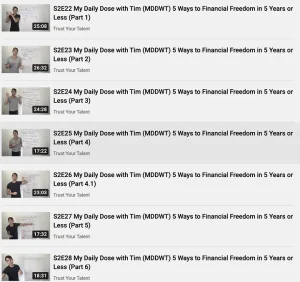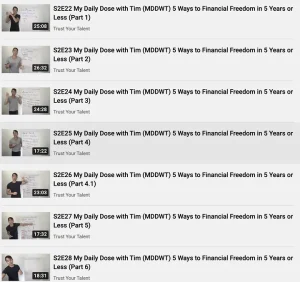Financial Education through Real Estate Investing: Know the Difference — How to Spot an Amateur vs a Professional (Part 2)
August 2, 2022
Times like this right now are even more crucial to make sure that nobody falls into any traps set by desperate and hand-to-mouth “professionals”. These are lessons that were passed down to me by my Mentors along the way and — as usual — some of them I had to learn the hard way because I didn’t listen.
Before we go any further, I want to thank everyone who reached out to share that you could relate to some of my journey (especially the ones shared in the last article). My story may not be the most extraordinary (and it doesn’t have to be), as long as I’m making a difference in the world by sharing it, I’ve fulfilled my purpose here.
Some of you have also reached out to say that I seem to have gotten a little ‘too real’ here and there in the last few articles. Well, I don’t know what to tell ya other than a) I write like I talk, b) I’m looking to share authentically and c) I’m definitely lying if I tell you it’s all going to be rainbows and butterflies if you just get financially educated. That’s like saying “if you just go to school and get academically educated, the rest of your life is set”.
Often times, one of the first things I ask for when I get to share publicly is this: do you want me to tell you what you need to hear or what you want to hear? Almost in unison, it would be “what you need to hear” every time. Look — I’m not here to burst anyone’s bubble and I’m certainly not perfect, and I’m definitely here to share enough of my learnings with you so that you get to bypass some or most of the mistakes that I have made. The mistakes that have cost me millions (literally), sleepless nights, gallons of tears and sweat, and occasional yet severe self doubts about my ability to succeed at all.
Part 1 of this topic was better received that I could have ever imagined. I remember watching one of Robert Kiyosaki’s interviews. He said: “Overnight, I became the most hated man amongst all real estate agents in America because I’m telling people that your house is not your biggest asset, it’s your biggest liability.” These days, I can completely relate to that feeling. The truth when it comes to investing and money can often be unsettling, unwelcoming, unpopular and ill-received by many. Call me dumb, call me passionate, call me anything you want — but that’s the fuel for Part 2 of this same topic.
So, here we go again. And today, we’re only going to focus on ONE thing:
Using “Raising Capital” as a Marketing tool or Part of a Tag Line
This one is arguably the most used ‘phrase’ amongst the least educated. Or, worse yet — those with ulterior motives.
Before some of you bite my head off here, I’ll be the first to admit that “raising capital” is a legitimate activity, skill and business process not only for real estate investors, but for all entrepreneurs.
1. “Raising Capital” as a Marketing Tool
Strictly speaking about real estate investing, needing access to capital is the one topic that newbies dread and are often frightened by the most. The reality is: if the deal is good, the money will follow. Amongst all the Trainers and Mentors are Trust Your Talent, we always say to our students that “one day, you’ll have more money than you have deals.” Nobody initially believes us. Nobody. Then months and a couple of short years go by, one by one, they would come back and say things like: “I have money investors lining up and I have no deals!”
Let’s unpack that quickly here.
It’s not that there are no deals. It’s the fact that we’ve learned better as we do more deals and have gathered more experiences. We’ve simply tightened our business process, tweaked our investment criteria and goals along the way. As a result, elevated the demand of our deal quality over time.
I’ve also been saying to my students lots over the years: “if your first deal is your best one, you’re doing it wrong”. Again, if you know me, you know I love my grey area and seldom use words like right or wrong. I generally prefer “good or bad”, and “better or worse” in any situation.
Circling back to why this is seen as an amateur move is simply because of these reasons:
- Especially for newbies, knowledge and experience count first and foremost. I can be biased because I attribute any of my current financial success to the financial education that I got and applied over the years. It’s like most of us fresh out of school and applying for our first ‘real’ job in the world. It’s the classic paradox — you need to work to get experience and you also need experience to get work. When that’s not the case, the shortcut is typically having some kind of eduction backing us — be it academic or skill-specific.
- In order for some one to have the confidence in us and our deals, there are several factors at play here. Without digging into character and personality types, knowing how to find opportunities, analyze them and determining them as ‘good’ deal is step 1. This can be and often is accomplished by proper training on specific investment strategies.
- As both an active and passive investor, if you can’t (and I quote Jerry McGuire lovingly with all my heart) “SHOW ME THE MONEY”, you ain’t got a chance to get my money now, or ever!
- Investing can easily be a very logical activity — let the numbers do the talking and leave your emotions at the door. This is why learning how to identify exit strategies for any opportunities is what really separates the professionals and the amateurs. I often say: your exit strategies determine how you make money and how much you make.
- Why ‘exit’, you ask? Because getting into deals is actually the easy part especially for those who are untrained, emotional and easily swayed. I have an investor friend who jokes: “When the times are good, my 15 year-old daughter can make money from just buying and selling real estate, too!” Getting the money isn’t the be all end all. It’s just the beginning.
So, what’s the point here?
Simple — I’m looping back to knowing why you want to invest in the first place. What’s your goal? Which income bucket are you wanting to feed? How do you want your Wheel of Wealth to look like? What’s your S.M.P. as a result? Having clarity to these question is probably the BEST thing you can do for yourself. Otherwise, every opportunity can look like a ‘good deal’ and every ‘raising capital’ training or podcast can steal your most previous gift and stall your progress.
2. Using “Raising Capital” as Part of a Tagline
Often times, I see people who put things like these on their social media profiles:
- Raised $120 Million
- Owns $5.1 Billion in Real Estate
- Sourced 9 Figures to Acquire 1,500+ Units
Impressive? Yes!
True? Maybe.
Meaningful? No. (At least, not to me after 12 years in the game.)
I’ll be the first to tell you that I sought out people with these tag lines to learn from years ago when I first started out. After all, I also preach “follow the footsteps of the people who have accomplished what you want to accomplish”.
Here’s a quick graph to share with you before I go on:

I realized that I already had all the tools I needed through my training. It simply became “how can I share the wealth with others”.
Of course, it’s a little deeper than that. Here are a few reasons:
- While those tag lines mentioned above are super impressive, here’s what anyone reading this right now needs to get clear on: WHY are you investing in the first place? (Am I sounding like a broken record yet?)
- One of my Mentors illustrated the concept of ‘not needing a lot to accomplish financial freedom’ by asking this question: have you ever flown in an airplane before? Either way, the next time you fly and just seconds after the plane takes off, put your thumb on the window against the land below you. THAT is about how much real estate you need to be free for the rest of your life. And maybe for the many generations after you.” That was not an easy concept for me to grasp if I’m being completely honest here.
- Here’s what I’ve discovered for myself: if your answer is financial freedom to the question above (first bullet point) and you need $5,000/month to reach Financial Freedom #1 (refer to all linked articles if needed), the math can be simple. Assuming you have zero capital and no mortgage qualification after you’ve invested in your education (one of the biggest questions we get), you therefore need to rely on leveraging OPM (other people’s money) to get going. Let’s say you are running on a 50/50 split structure (keep in mind that this is all a very high level illustration of the concept): $5,000/month = $60,000/year.
- Depending on your strategies (usually a mix of a few if you’re properly trained as an investor), say your average cash-on-cash return is 10%, it means you need to have $600,000 in capital working for you just to cover your 50%. This now means you actually need to have $1,200,000 making 10% per annum at this point. Then the goal now is to find enough people (yes, plural — at least for most of us in the beginning) who’s willing to fund $1,200,000 in cash/capital before leveraging. If you’re leveraging at an average of 75% LTV (loan to value) on your acquisitions, this means that you are managing a portfolio of $4,800,000.
- As you can clearly see, raising $120,000,000 is great, and yet not quite necessary yet. Learning to honour your own financial freedom goals in the beginning is the most challenging and rewarding thing you can do for yourself so you do not fall into crafty marketing tactics.
- Another perspective I will also share here (and it’s a little dark — don’t say I didn’t warn you): there are quite a few people who only share how much money they’ve ‘raised’ over an unspecified timeframe, and not share the results of how much the funds they raised have made or even lost. I personally know a few like that and they are, unfortunately, still actively teaching others their methods. Of course, investing inherently has risks. I can also relate due to personal experience. Remember how I shared that I lost $1M overnight? In actuality, it was losing $1M in capital, over $5M in assets, >$300,000 in debt servicing and legal fees over the course of 3.5 years. Not to mention losing my pride, sanity and sense of self for a while.
- Listen (and I expect you to put on your best Oprah listening pose right now): I’ve known people with thousands of doors and have to hustle to keep the portfolio going. I’ve also known people with a couple dozen well-managed doors and their passive cashflow allows them to live life without a single worry till the day they die. Don’t let your ego get in the way because you want to sound like a big shot. I know I worshiped those who looked like they’ve accomplished on the outside. Then I learned to really look at what they are like on the inside that counts.
- Next, in business, we speak of asset and income protection. It’s difficult to even begin to discuss how incredibly stupid with claims like “I own X of real estate” since control without owning is (in my humble opinion) the absolutely highest art form of business and entrepreneurship. The world most valuable businesses today did not receive their valuation from goods and manufactured products sold. They got it from the appraisals and perceived values of the business’s combined systems, processes and good will. Unless you’re a public company, I would never recommend anyone who have built a success portfolio or business of any sort (especially when it’s largely built on OPM) to openly disclose value as it also tends to get misinterpreted in context.
- Lastly, like an annoying teenager, I might be stating the obvious a bit — what is “9 figures”? 100,000,000 is 9 figures. So is $999,000,000.
Phew! That wasn’t so hard.
Tomy dedicated readers, I thank you for your support and feedback. If this is the first time you’re reading one of my publications, I hope you’ve enjoyed it and learned a thing or two.
If you’re wanting to be a part of a community of real estate investors from around the globe, here is the T.A.L.E.N.T.ed Investors Facebook Group. It’s a place where people come together to share experiences, knowledge, successes and challenges, and money making opportunities!
For those of you who prefer watching videos, here is the YouTube channel where some of my work (very raw) has been shared.

If you prefer the live interaction and delivery to help you build some foundation, our next live in-person real estate investing Bootcamp is on September 24 and 25 in Toronto. Go ahead and speak to a Strategy Coach on how you can attend.
Lastly, I just want to say thank you for your continuing support.
I aim to be authentic and adding value to your life.
I invest to build a life. I build business to create better life experiences.
It’s ultimately about LIFE and I appreciate you coming on this journey with me!
(Written at the Maple Leaf Lounge in Calgary International Airport and completed in Cleveland, OH)













